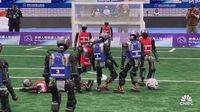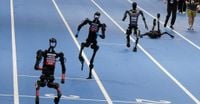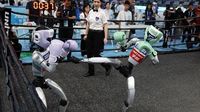The world’s first-ever World Humanoid Robot Games wrapped up in Beijing this week, delivering a spectacle that blended athletic ambition with the mechanical whir of innovation. Over the course of three days, more than 500 androids—built and programmed by 280 teams from 16 countries—took to the field at the National Speed Skating Oval, the same arena that hosted the 2022 Winter Olympics. The event, sometimes called China’s “Robot Olympics,” drew crowds of tens of thousands, all eager to witness a new era of competition where the athletes were made not of flesh and bone, but of circuits and steel.
From the outset, the Games were designed to push the boundaries of what humanoid robots can do. Events ranged from traditional sports like running, basketball, football, and boxing to more utilitarian challenges such as medicine categorization and household cleaning. Organizers made it clear: this wasn’t just about robots for show—it was about demonstrating practical, real-world capabilities. According to AFP, the spectacle included everything from 100-meter hurdles to kung fu, showcasing both the promise and the current limitations of robotics.
The opening day’s five-a-side football match set the tone. Ten robots, each about the size of a seven-year-old child, shuffled across the pitch, often tumbling over one another in a mechanical scrum. Laughter and cheers echoed through the stands as the robots struggled to maintain balance, sometimes falling en masse. Yet, amid the stumbles, there were flashes of brilliance. In the 1,500-meter race, a domestic champion from Unitree stomped around the track at a brisk pace, finishing in 6 minutes, 29.37 seconds—a time that, while impressive for a robot, still lags far behind the human men’s world record of 3:26.00. In a moment that had the crowd gasping, one robot barreled straight into a human operator. The machine remained standing, while the human was knocked flat (thankfully, no injuries were reported).
But the Games weren’t just about athletic prowess. Events like material handling simulated real-life factory scenarios, and medicine sorting demonstrated how robots could one day support healthcare. As South China Morning Post reported, X-Humanoid (the Beijing Humanoid Robot Innovation Centre) took home gold in the novel materials handling event, underlining the potential of robots in industrial settings.
The competition was fierce, with universities and established robotics companies vying for medals. Unitree, a well-known Chinese robotics firm, emerged as a dominant force, collecting 11 medals—including four golds—in running events such as the 1,500-meter, 400-meter, 100-meter, and 4x100-meter relay. One of Unitree’s robots hit a top speed of 4.78 meters per second (about 10 mph), and in the 100-meter sprint, clocked a time of 33.71 seconds. While still far from Usain Bolt’s legendary 9.58 seconds, it’s a leap forward for humanoid machines. X-Humanoid followed closely with 10 medals, including two golds. According to an IDC analyst cited by South China Morning Post, “China has grown from a follower to a leader in this area.”
More than just a showcase of robotics, the Games highlighted China’s ambitions in artificial intelligence and technology. As noted by the International Federation of Robotics, Beijing has placed humanoid robots at the “centre of their national strategy.” In March 2025, the Chinese government announced a one-trillion-yuan ($139 billion) fund to support technology startups, with a strong emphasis on robotics and AI. The country is already the world’s largest market for industrial robots, and in April, Beijing hosted what organizers called the world’s first humanoid robot half-marathon.
Behind the scenes, technology played a critical role in making the event possible. According to Newsfile Corp, China Unicom Beijing provided full 5G-A network coverage both inside and outside the National Speed Skating Oval. This cutting-edge network, with its high uplink capacity, reliability, and security, enabled more than 500 robots from nearly 280 teams to compete at their best—whether in athletic, performance, industrial, or healthcare contests. The robust 5G-A infrastructure also enhanced the experience for the tens of thousands of spectators, allowing for seamless live streaming, media uploads, and instant sharing of videos.
“Our 5G-A networks currently serve users, and we’re upgrading them to support embodied AI as well,” said Qin Yang, Deputy General Manager of China Unicom Beijing. “Our 5G-A network for this event reflects this progress. It dedicates a channel for spectators and a dynamically scalable one for robots, realizing seamless connectivity for both spectators and robots even during peak usage. In the robot sector, 5G-A will also be key to enabling low-latency remote control.”
Inside the venue, a digital indoor system utilizing 300 MHz ultra-high-bandwidth spectrum delivered uplink speeds above 100 Mbps, supporting multiple 4K machine vision streams without frame loss and keeping air interface latency below 20 milliseconds. Outside, a 5G-A 3D network coordinated high and mid bands to achieve downlink speeds of up to 11.2 Gbps and uplink speeds of 4 Gbps. This allowed media outlets such as CCTV to upload ultra-high-definition signals in seconds, while crowds could share their experiences without a hitch.
Samuel Chen, Vice President of Marketing for Huawei’s Wireless Network Product Line, emphasized the technical challenge: “At the humanoid robot games, the network must support many robots, spectators, and live media streams. It needs to provide high uplink capacity, low latency, high reliability, and wide coverage.”
While the Games dazzled with their ambition, they also revealed the current gap between robots and humans. Many teams treated the competition as a stress test, pushing their machines to the limit under the pressure of a live audience. Some robots wowed with agility and speed, while others struggled with coordination, offering moments of both awe and comic relief. The event’s organizers and participants were quick to point out that the goal was not to outpace human athletes, but to advance the science of robotics. As one 18-year-old spectator, Chen Ruiyuan, told AFP, “I believe in the next 10 years or so, robots will be basically at the same level as humans.”
Perhaps the greatest achievement of the World Humanoid Robot Games was its ability to bring together the worlds of sport, science, and spectacle. It offered a tantalizing glimpse of a future where robots might not only entertain, but also assist in everyday life—whether on the factory floor, in the hospital, or even at home. With China’s heavy investment and the global robotics community energized by this inaugural event, it seems all but certain that the next chapter in humanoid robotics is just beginning to unfold.


